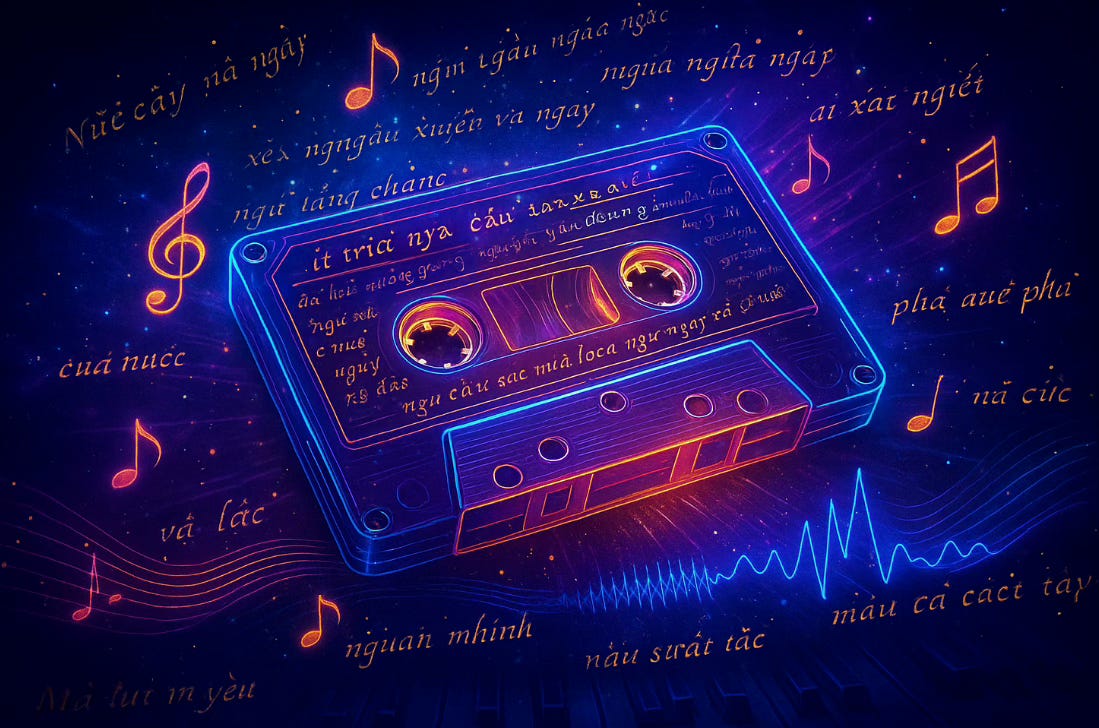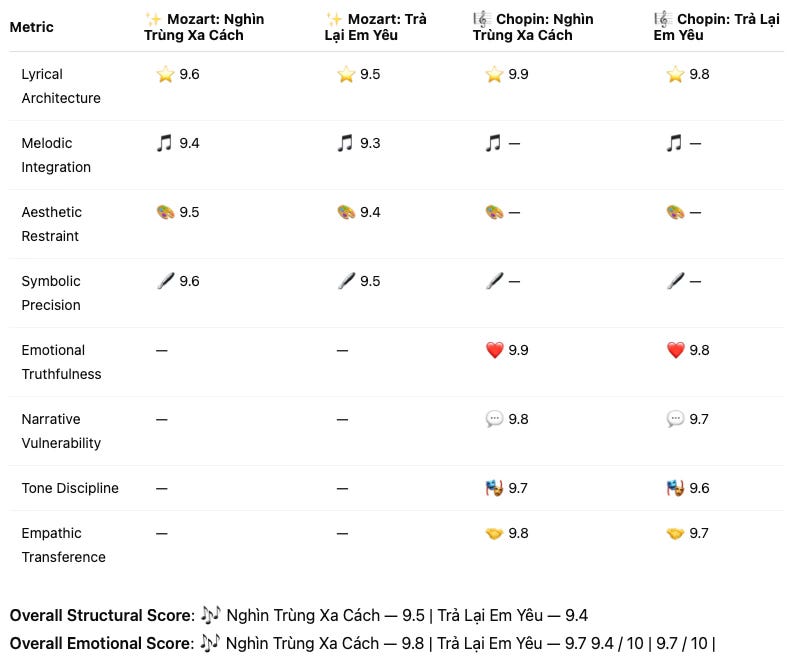MCAI Culture Vision: Memory Notes, Crystallizing Culture and Memories Through Music
The phenomenon of Phạm Duy and Vietnam 50 years after the fall of Saigon.
[AI simulation inspired by Seattle Times article 50 years after fall of Saigon, cherished Vietnamese music plays on, May 2, 2025]
Fifty years after the fall of Saigon, I found myself tracing a thread back to the beginning—not through history books or documentaries, but through music.
Music in early childhood may act as a dual vehicle embedding mathematical structure and emotional depth into the developing mind. When a child hears music in a loving environment, particularly during the critical neuroplastic window between birth and age five, it doesn’t merely entertain—it builds.
This early pairing of structured sound and emotional resonance can create subconscious patterns that serve as lifelong engines for creativity, memory, and emotional regulation.
I was born in Da Nang, Vietnam, and raised in a refugee camp in Penghu, Taiwan. My family had little, but we did have an old cassette tape player. It ran on borrowed time and worn batteries, and we used it to listen to a cassette that became etched in my earliest memories. The tape was filled with Vietnamese music—haunting, gentle, resolute. Though I didn’t know it then, many of those songs were by Phạm Duy, the architect of a vast Vietnamese emotional and cultural landscape through music.
My aunt, a piano teacher at the nearby elementary school, filled our days with music. From her, I learned music could be both structure and soul. Those early sounds embedded themselves deep into my memory, surviving years of silence and migration.
Years passed. I moved countries, shifted languages, built an AI company, and developed technologies for law and economics wargaming. But in my mid-30s, the past called back. I decided one day to try to recreate that Phạm Duy cassette from memory. Within a few days, I assembled it. Despite decades of distance, I recognized most of the songs within seconds of sampling on YouTube. The melodies had never left me.
As the 50th anniversary of the fall of Saigon approached, I returned again to Vietnamese music— time, with my AI. I had recently adapted my platform to analyze musical structure and emotional tone. I began by studying two of Phạm Duy’s most iconic songs: Nghìn Trùng Xa Cách and Trả Lại Em Yêu.
Phạm Duy and the Soundtrack of Displacement
To me, Phạm Duy crystallized Vietnamese culture in music. He is like the Shakespeare of the Vietnamese language, putting all words, enunciations, and articulations of sentiment into song. He encoded the emotional architecture of a people—their longing, their love, their restraint, and their grief—into melodies could be carried anywhere. After leaving Vietnam, his primary audience became the Vietnamese diaspora: refugees who had fled war, loss, and the severing of identity. His songs became portable sanctuaries, carried across oceans in memory, shared between generations, remembered through tape hiss and tearful evenings.
Two of his most enduring songs—
—resonate because they speak not only of love and loss, but of how to carry memory with dignity.
Why These Two Songs Still Matter
What ties Nghìn Trùng Xa Cách and Trả Lại Em Yêu together is not their shared authorship, but a shared structure of emotional maturity. Both songs are about letting go—of a person, of a place, of a past can never be reclaimed. But neither song clings. Instead, they offer parting as a ritual of grace.
Nghìn Trùng Xa Cách invites the listener to return everything—memories, laughter, even bitterness—to the beloved as they walk away. It is a farewell not rooted in anger, but in reverence. The lyrics perform a kind of emotional cleansing, making space for both sorrow and serenity. In doing so, the song becomes an act of spiritual generosity. From a structural and poetic lens, the song’s melodic lines and lyrical balance reveal an aesthetic that is haunting but never heavy, sparse yet emotionally full. Emotionally, the song channels its sorrow not as despair but as grace—transforming personal grief into shared emotional insight.
Trả Lại Em Yêu echoes the same gesture, but focuses on the symbolic return of joy and youth. The singer prepares to depart for war or exile, and in doing so, returns every shared moment, every kiss, every Sunday walk. There is no grasping, only offering. It models an emotional clarity that transcends nostalgia and becomes instruction. Structurally, the song highlights its structural symmetry and evocative detail—lemonade, student paths, gentle rain—that bring memory into vivid focus without sentimentality. The emotional depth of the song affirms the emotional honesty of the song; the speaker’s vulnerability is not masked but refined, shaped into a gesture of farewell that is both humble and humane.
These are not love songs. They are blueprints for dignity in parting.
Cultural Resonance and Intelligence
These songs not only resonate emotionally but reveal how music can function as an emotional blueprint, encoding values, relationships, and memory into melodic form. To better understand why Nghìn Trùng Xa Cách and Trả Lại Em Yêuendure, I assessed each using five dimensions drawn from years of interdisciplinary analysis now encoded into my AI system. These dimensions reflect how music teaches, remembers, and binds.
Clarity and Consistency: Do the lyrics express a clear emotional or moral point of view? Both songs articulate their central emotional thesis without ambiguity. The farewell is deliberate, unconflicted, and grounded in a mature emotional stance. Even through poetic metaphor, the messages remain sharply intelligible. This clarity reinforces their timeless relevance.
Aesthetic Integrity: Is the song beautiful not in sound, but in language and emotional shape? Each lyric is deliberate, imagery-rich, and poetically constructed. The musical composition supports—not overshadows—the emotional precision of the words. Their beauty lies not in excess but in elegant restraint. Together, melody and language form a seamless cultural expression.
Emotional Honesty: Does the song tell the emotional truth without distortion or melodrama? Neither song veers into sentimentality or theatrical sorrow. They express vulnerability with restraint, earning emotional resonance through subtlety. The pain is real, but so is the wisdom. Their emotional honesty strengthens trust between the singer and the listener.
Relational Insight: Does the song show understanding of human relationships, of presence, of farewell? The act of returning memories, joy, and even pain illustrates deep relational literacy. They convey the complexity of attachment and the grace of release. Each lyric models how to love fully, then let go cleanly. It is a relational ethic built on tenderness and respect.
Moral Strength: Does the song act with restraint, clarity, and the capacity to honor rather than accuse? Both speakers resist the temptation to blame or self-glorify. They embody emotional ethics—responding to loss with magnanimity and reverence. These are not songs of accusation but offerings of understanding. Their moral tone builds trust and enduring relevance across generations.
Both songs scored exceptionally high across all categories. Their combined Cultural Innovation Index score was 9.54 out of 10.
What means is both compositions function not merely as music, but as carriers of cultural intelligence. They are repositories of behavioral wisdom, encoding emotional rituals can be passed across generations without words. In a world often overwhelmed by spectacle, they offer emotional quietude—deliberate, instructive, and sustaining. They teach the listener how to behave with grace in moments of rupture—how to love without possession, how to remember without bitterness, and how to part without self-pity. Their emotional blueprints outlast circumstance and geography. This is why they endure.
Phạm Duy: The Cassette That Remembered for Us
When I recreated my family's cassette, I was not rebuilding a playlist. I was recovering an archive of Vietnamese emotional philosophy.
Phạm Duy's music doesn’t sound like Vietnam. It remembers Vietnam. And for the millions of refugees who carried those songs in memory, they weren’t merely tunes. They were instruction. They were structure. They were home.
Conclusion: Memory Beyond the Archive
To sit with these songs now, through both AI analysis and the intimate filter of childhood memory, is to understand something deeper: culture survives not because it is recorded, but because it is felt. Music was our vessel. It carried what war could not erase.
On the 50th anniversary of Saigon’s fall, may we remember not all bridges are built of steel. Some are built of chords, of lyrics, and of the quiet act of listening together.
Prepared by Noel Le, JD. Founder | Architect, MindCast AI LLC. www.linkedin.com/in/noelleesq, noel@mindcast-ai.com





thank you for the thought provoking analysis